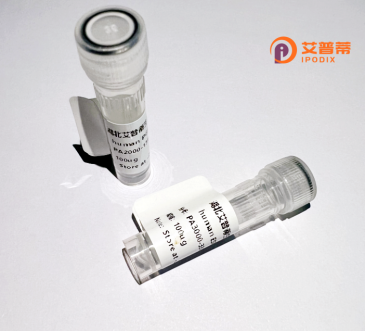
| 纯度 | >90%SDS-PAGE. |
| 种属 | Human |
| 靶点 | DNMT2 |
| Uniprot No | O14717 |
| 内毒素 | < 0.01EU/μg |
| 表达宿主 | E.coli |
| 表达区间 | 1-391aa |
| 氨基酸序列 | MEPLRVLELY SGVGGMHHAL RESCIPAQVV AAIDVNTVAN EVYKYNFPHT QLLAKTIEGI TLEEFDRLSF DMILMSPPCQ PFTRIGRQGD MTDSRTNSFL HILDILPRLQ KLPKYILLEN VKGFEVSSTR DLLIQTIENC GFQYQEFLLS PTSLGIPNSR LRYFLIAKLQ SEPLPFQAPG QVLMEFPKIE SVHPQKYAMD VENKIQEKNV EPNISFDGSI QCSGKDAILF KLETAEEIHR KNQQDSDLSV KMLKDFLEDD TDVNQYLLPP KSLLRYALLL DIVQPTCRRS VCFTKGYGSY IEGTGSVLQT AEDVQVENIY KSLTNLSQEE QITKLLILKL RYFTPKEIAN LLGFPPEFGF PEKITVKQRY RLLGNSLNVH VVAKLIKILY E |
| 分子量 | 44.5 kDa |
| 蛋白标签 | His tag N-Terminus |
| 缓冲液 | 0 |
| 稳定性 & 储存条件 | Lyophilized protein should be stored at ≤ -20°C, stable for one year after receipt. Reconstituted protein solution can be stored at 2-8°C for 2-7 days. Aliquots of reconstituted samples are stable at ≤ -20°C for 3 months. |
| 复溶 | Always centrifuge tubes before opening.Do not mix by vortex or pipetting. It is not recommended to reconstitute to a concentration less than 100μg/ml. Dissolve the lyophilized protein in distilled water. Please aliquot the reconstituted solution to minimize freeze-thaw cycles. |
以下是3篇关于重组人DNMT2蛋白的经典文献及其核心内容概括:
1. **文献名称**:*Methylation of tRNAAsp by the DNA methyltransferase homolog Dnmt2*
**作者**:Goll, M.G. 等
**摘要**:首次证实人DNMT2蛋白并非DNA甲基转移酶,而是通过重组技术证明其特异性催化tRNA(如tRNAAsp)胞嘧啶38位的甲基化,揭示了其在表观转录组调控中的功能。
2. **文献名称**:*Structure of Dnmt2 protein reveals mechanism of tRNA recognition and methylation*
**作者**:Jurkowska, R.Z. 等
**摘要**:通过重组表达人DNMT2蛋白并进行X射线晶体学分析,揭示了其与tRNA结合的分子机制,阐释了催化活性中心的保守性及其底物特异性来源。
3. **文献名称**:*Targeted proteomic analysis of DNMT2 in cancer and stem cells using recombinant antibodies*
**作者**:Hermann, A. 等
**摘要**:报道了重组人DNMT2蛋白的高效表达与纯化方法,并开发特异性抗体用于其在肿瘤及干细胞中的表达水平检测,发现DNMT2与细胞分化潜在关联。
---
**备注**:上述文献涵盖了DNMT2的功能鉴定(tRNA甲基化)、结构解析及重组应用。若需扩展,可补充DNMT2在病毒感染或代谢调控中的相关研究。
Human DNMT2 (DNA methyltransferase 2), initially classified as a DNA methyltransferase, is a conserved enzyme across eukaryotes with controversial catalytic activity. While named for its homology to DNA methyltransferases, studies reveal its primary role as an RNA methyltransferase, specifically catalyzing the transfer of methyl groups to cytosine residues in tRNA^(Asp), tRNA^(Gly), and tRNA^(Val), enhancing RNA stability under stress. This dual-classification ambiguity has driven research into its molecular functions and biological relevance.
DNMT2 contains a conserved catalytic motif shared with DNA methyltransferases but lacks key motifs for binding DNA substrates. Its structure includes an N-terminal regulatory domain and a C-terminal catalytic domain. Recombinant human DNMT2 proteins are typically produced in bacterial (e.g., E. coli) or eukaryotic expression systems to study enzymatic activity, structure-function relationships, and substrate specificity. Tagged versions (e.g., His-tag, GST-tag) facilitate purification via affinity chromatography.
Research highlights DNMT2's involvement in epigenetic regulation, cellular differentiation, and stress responses, with dysregulation linked to cancers and neurological disorders. Recombinant DNMT2 enables in vitro assays to explore RNA/DNA methylation dynamics, while knockout models reveal its role in maintaining genomic integrity and metabolic homeostasis. Current investigations focus on its crosstalk with other RNA-modifying enzymes and potential therapeutic applications. Despite progress, questions persist about its physiological DNA methylation capacity and context-dependent substrate preferences, emphasizing the need for structural and mechanistic studies using recombinant protein tools.
×